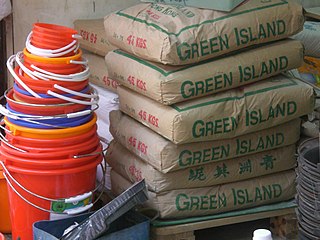
Green Island Cement is Hong Kong's only major cement producer. It was a former listed company in Hong Kong and was delisted from the Hong Kong Stock Exchange. It was founded in Green Island, Macau in 1887, and has established operations in Hong Kong and South China. It operates 6 concrete plants in Hong Kong with a total of 11 production lines, and 3 quarries each in Hong Kong and Mainland China. It is a wholly owned subsidiary of Cheung Kong Infrastructure Holdings.

Mobarakeh Steel Company is a private Iranian steel company, located 65 km south west of Esfahan, near the city of Mobarakeh, Esfahan Province, Iran. It is the largest steel maker of MENA region, and one of the largest industrial complexes operating in Iran. It was commissioned after the Iranian Revolution in 1979 and initiated operations during 1993. It underwent major revamping during year 2000, and is scheduled for a second and third revamping in 2009–2010, bringing the total steel output to 7,200,000 metric tons per year. The company owns the successful football club, Sepahan. In, 2022, this company employs over 14,000 people and generates more than 5.5 billion dollars per year. The company is not only a steel producer but also owns a number of other small steel producer, power plants, substations, mines, and a gas field.
The Arabian Cement Co. (ACC) is a Libyan company involved in production of cement, lime, gypsum and paper bags for cement packaging, and other construction related operations. It has a total production capacity of roughly 3.340 million tons per year (t/yr) and currently operates seven plants throughout Libya. The company's investment volume was estimated at Ld 180 million.
The mineral industry of Mozambique plays a significant role in the world's production of aluminium, beryllium, and tantalum. In 2006, Mozambique's share of the world's tantalum mine output amounted to 6%; beryllium, 5%; and aluminium, 2%. Other domestically significant mineral processing operations included cement and natural gas.

Lucky Cement Limited, also known as Yunus Brothers Group, or Lucky Group, is a Pakistani conglomerate company headquartered in Karachi, Sindh. Named after the place, Lakki Marwat, where the first plant was commissioned in 1993, Lucky has become one of the largest cement producers in Pakistan. It has 15.3 million tonnes per annum of manufacturing capacity. The company is listed on the Pakistan Stock Exchange.
Hrazdan Cement CJSC is a closed joint-stock company located in the town of Hrazdan, the provincial centre of Kotayk Province, Armenia. Founded in 1970 as "Hrazdan Cement Factory" by the Soviet government, the plant was privatized in 2001 to become owned by "MIKA Ltd.". In July 2014, a new group of owners took over the factory.

Loma Negra Companía Industrial Argentina S.A. is an Argentine manufacturer and the country's leading maker of cement, concrete, and lime. The company, established by businessman Alfredo Fortabat, also founded its own sports club, C.S.yD. Loma Negra three years later. After the passing of Alfredo Fortabat, his wife Amalia Lacroze took over the business.
Cement Corporation of India Limited (CCI) is the only cement manufacturing Public Sector Undertaking of Government of India. The company was incorporated as a wholly government-owned corporation on 18 January 1965, with the objective of setting up cement units in public sector to help achieve self-sufficiency in cement production in the country.
The Stellantis Rennes Plant is one of the principal car plants in France, producing approximately 340,000 cars in 2005. The Rennes plant was acquired by the PSA Group in 1976 when Peugeot took a majority stake in the Citroën company which had built the plant.

PT Semen Padang is the state-owned company that became oldest cement plant in Indonesia, having been founded in 1910.

Aalborg Portland is a cement-producing company in Denmark. It was established in Aalborg in the 19th century. Portland cement was patented in 1824 by the Englishman Joseph Aspdin. Six decades later the Aalborg businessman Hans Holm and the engineer Frederick Læssøe Smidth built a cement factory 4 kilometres (2.5 mi) northeast of Aalborg in the town of Rørdal.
East African Portland Cement Company commonly known by its abbreviation EAPCC, is a Kenyan based construction company specializing in the manufacturing and selling of cement and cement related products.
The Battle of Benghazi was a battle of the Second Libyan Civil War. It was fought in May and July 2014 between the Islamic Shura Council of Benghazi Revolutionaries and the Libyan National Army, and some residents which stood with the army in the city. The Shura Council of Benghazi Revolutionaries led by Ansar al-Sharia (Libya) has been designated as a terrorist organization by the United Nations, Turkey, the United Arab Emirates, the United Kingdom and the United States.

Maple Leaf Cement is a Pakistani cement manufacturer based in Lahore. It is the fifth-largest cement manufacturer in Pakistan after Lucky Cement, Bestway Cement, Fauji Cement, and DG Cement.

Cimerwa Cement Limited (CCL) is a manufacturer of cement in Rwanda with capacity of approximately 600,000 tones per year.
Lafarge Africa Plc is an industrial company headquartered in Lagos, Nigeria, and listed on the Nigerian Stock Exchange. It is majorly controlled by the Holcim Group. Previously trading under the name of Lafarge Wapco Plc, the merger of Lafarge and Holcim and resulting consolidation of Lafarge's assets in Nigeria and South Africa resulted in the name change to Lafarge Africa.

Attock Cement Pakistan Limited, doing business as Falcon Cement, is a Pakistani cement manufacturer headquartered in Karachi, with manufacturing plant in Hub, Balochistan. It was incorporated in Pakistan on 14 October 1981 as a public limited company. It is a subsidiary of Pharaon Investment Group Limited Holding S.A.L, Lebanon.
BUA Cement PLC is a publicly listed firm headquartered in Nigeria, it produces and markets cement products in the country. It is the second largest producer in Nigeria after Dangote Cement. The company was formed through the consolidation of the cement interest of the BUA Group, promoters of Obu Cement Company and the Kalambaina Company majority owned Cement Company of Northern Nigeria.

Wonder Cement is an Indian cement producing company that is based out of Rajasthan. It was started in 2010 under RK Group. It manufactures Portland pozzolana and ordinary Portland cement for plaster, brickwork, and other construction applications.









